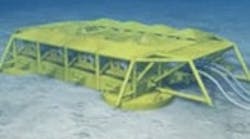The Ormen Lange gas field, discovered off the coast of Norway in 1997, contains an estimated 400 billion standard cubic meters of gas. But getting at the gas is no easy feat, given water that’s 1,000 m deep, subzero temperatures, an irregular bottom and strong ocean currents. The stream of gas, condensate and water produced from sub-sea wellhead equipment is transported via pipeline through fishing grounds and around areas of coral to an onshore plant, before the gas is sent to the offshore Sleipner platform and then on to England, a distance of some 1,000 km.
Royal Dutch Shell, which operates the field, relies increasingly on remote access to efficiently and effectively manage these difficult-to-reach assets: remote access by its own experts as well as the contracted expertise of ABB. “Ormen Lange Smartfield solutions is a set of physical assets, data, models and simulation,” explained Bjarte Onar Birkeland, service environment manager, oil & gas, automation technologies division, who spoke on use of remote services by Shell at ABB Automation and Power World 2009 this week in Orlando, Fla.
“You have to acquire data, interpret and model, generate and evaluate options, and execute,” he said. “Decision makers are in many different places.” Collaboration between three different Shell offices in Norway is critical to operate the plant. Data transmissions, processing, interpretation, modeling decision management and central systems all must be coordinated. “Remote service and allowing everyone to work together with the same work processes and procedures are crucial,” explained Birkeland. “The goal is low on-site manning. There are no specialists on-site. They had a goal of 70% condition-based maintenance by 2009. This puts a design constraint into your instrumentation and your automation system. They’ve had a successful implementation. In 2008, they had 16 companies with thousands of remote access connections.”
“The goal is low on–site manning. There are no specialists on–site.” ABB’s Bjarte Onar Birkeland explained how remote services are enabling Shell to realize, among other goals, 70% condition–based maintenance in gas production facilities.
Modern oil, gas and petrochemical operations rely on advanced technological solutions to optimize production, reduce operating costs, increase safety and extend the overall field lifecycle, said Birkeland. Shell undertook a five-year service agreement with ABB for its Ormen Lange plant, as well as the existing Draugen offshore platform. “This contract is all about providing value to the strategy of operations,” he explained. “The Shell contract is not a full-service contract. It’s a bundled services contract. To get this to work in a remote environment, you need processes that are monitored and quality-assured. The remote work is mostly operations management.”
While remote access was added to the existing Draugen platform, the system design phase is the optimal point for including remote access. “You can increase the overall benefit by remote work,” explained Birkeland. “You can put system recovery plans in place. Detecting the first failure before the second occurs is very important.”
Ormen Lange is using ABB’s System 800xA, and Draugen added an 800xA on top of its existing system. ABB is single point of contact for all automation-related issues and for incidents, changes, field alerts and configuration management.
ABB performs and assists in the system operations to match Shell information security policy. Remote system monitoring is integrated with the site inventory so historical data can be considered, as well. Secure client server management, loop tuning and process optimization and preventive maintenance are all part of ABB’s remote capabilities and responsibilities. “And we’re responsible for system evolution planning in line with the plant’s overall shutdown windows,” explained Birkeland.
The Service Desk, which is both manned and automated, is the heart of where all information is collected. “It records the case type and dispatches it to the correct team within the defined time,” said Birkeland. “The team leader assigns it to a specialist, which could be any one of a variety of ABB resources all over the world. “We have 60 product groups and 400 engineers available to this group,” he said. “We’ve also added third parties. The customer and third parties have access to the same tools we do.”
Important aspects of Service Desk functionality include configuration, field alert and overall change management—all facilitated remotely. “Configuration items can relate to products, such as software, hardware or documents, or to sites—items such as services or systems. “The field alert service facilitates preventive maintenance. System owners are informed on software and hardware actually used at the site, and it eliminates potential incidents by learning from other sites,” he said. “It makes in-house, system-specific expertise unnecessary.”




